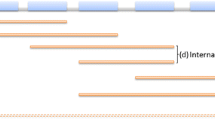Summary
By Northern blot and primer extension analyses it was shown that inBacillus stearothermophilus the genesinfC, rpmI andrplT constitute a single transcriptional unit; the promoter and the transcriptional start-point used in vivo were identified and the half-life of the transcript (1.2 min) was determined. No indication of multiple initiation sites nor of differential stability of different regions of the transcript was found. The results suggest thatEscherichia coli andB. stearothermophilus have a different pattern of transcription around theinfC gene cluster and that differential translational efficiency within theinfC-rpmI-rplT transcriptional unit accounts for the different levels of 1173, L35 and L20 expression. The rare AUU initiation codon is the only strictly conserved element of the several peculiar transcriptional and translational features found inE. coli infC. Upon changing this codon to AUG, we found a ca. 30-fold increased expression ofB. stearothermophilus infC, which is similar to that previously found withE. coli infC (i.e. 40-fold), and provided evidence that regulation ofinfC expression through its rare AUU initiation codon might be a general phenomenon in bacteria.
Similar content being viewed by others
References
Brombach M, Pon CL (1987) The unusual translational initiation codon AUU limits the expression of theinfC (initiation factor IF3) gene ofEscherichia coli. Mol Gen Genet 208:94–100
Butler JS, Springer M, Grunberg-Manago M (1987) AUU-to-AUG mutation in the initiator codon of the translation initiation factor IF3 abolishes translational autocontrol of its own gene (infC) in vivo. Proc Natl Acad Sci USA 84:4022–4025
Coleman J, Green P, Inouye M (1984) The use of RNAs complementary to specific mRNAs to regulate the expression of individual bacterial genes. Cell 37:429–436
Comer MM (1981) Gene organization around the phenylalanyltransfer ribonucleic acid synthetase locus inEscherichia coli. J Bacteriol 146:269–274
Davis L, Dibner M, Battey JF (1986) Basic methods in molecular biology. Elsevier, NY, pp 143–146
Gold L, Stormo G, Saunders R (1984)Escherichia coli translation initiation factor IF3: a unique case of translational regulation. Proc Natl Acad Sci USA 81:7061–7065
Gualerzi CO, Pon CL (1990) Initiation of mRNA translation in prokaryotes. Biochemistry 29:5881–5889
Gualerzi CO, La Teana A, Spurio R, Canonaco MA, Severini M, Pon CL (1990) Initiation of protein biosynthesis in prokaryotes. Recognition of mRNA by ribosomes and molecular basis for the function of initiation factors. In: Hill WE, Dahlberg A, Garrett RA, Moore PB, Schlessinger D, Warner JR (eds) The ribosome. Structure, function and evolution, American Society for Microbiology, Washington, DC, pp 281–291
Hennecke H, Springer M, Böck A (1977) A specialized transducing lambda phage carrying theEscherichia coli genes for phenylalanyl-tRNA synthetase. Mol Gen Genet 152:205–210
Hershey JWB (1987) Protein synthesis. In: Neidhardt FC, Ingraham JL, Low KB, Magasanik B, Schaechter M, Umbarger HE (eds)Escherichia coli andSalmonella typhimurium — cellular and molecular biology. American Society for Microbiology, Washington, DC, pp 613–647
Kimura M, Ernst H, Appelt K (1983) The primary structure of initiation factor IF3 fromBacillus stearothermophilus. FEBS Lett 160:78–81
Lammi M, Pon CL, Gualerzi CO (1987) The NH2-terminal cleavage ofEscherichia coli translational initiation factor IF3. A mechanism to control the intracellular level of the factor? FEBS Lett 215:115–121
Lesage P, Truong HN, Graffe M, Dondon J, Springer M (1990) Translated translational operator inEscherichia coli. Auto-regulation in theinfC-rpmI-rplT operon. J Mol Biol 213:465–475
La Teana A, Falconi M, Scarlato V, Lammi M, Pon CL (1989) Characterization of the structural genes for the DNA-binding protein H-NS in Enterobacteriaceae. FEBS Lett 244:34–38
La Teana A, Falconi M, Pawlik RT, Spurio R, Pon CL, Gualerzi CO (1990) The function of initiation factors in relation to mRNA-ribosome interaction and regulation of gene expression. In: McCarthy JEG, Tuite MF (eds) Post-transcriptional control in gene expression. Springer-Verlag, Heidelberg, pp 443–453
Mayaux JF, Fayat G, Fromant M, Springer M, Grunberg-Manago M, Blanquet S (1983) Structure and transcriptional evidence for related thrS and infC expression. Proc Natl Acad Sci USA 80:6152–6156
Pon CL, Gualerzi C (1979) Qualitative and semiquantitative assay ofEscherichia coli translational initiation factor IF3. Methods Enzymol 60:230–239
Pon CL, Brombach M, Thamm S, Gualerzi CO (1989) Cloning and characterization of a gene cluster fromBacillus stearothermophilus comprisinginfC, rpmI andrplT. Mol Gen Genet 218:355–357
Remaut E, Tsao H, Fiers W (1983) Improved plasmid vectors with a thermoinducible expression and temperature-regulated runaway replication. Gene 22:103–113
Springer M, Graffe M, Hennecke H (1977) Specialized transducing phage for the initiation factor 3 gene inEscherichia coli. Proc Natl Acad Sci USA 74:3970–3974
Wada A, Sako T (1987) Primary structures of and genes for new ribosomal proteins A and B inEscherichia coli. J Biochem 101:817–820
Wertheimer SJ, Klotsky R-A, Schwartz I (1988) Transcriptional patterns for thethrS-infC-rplT operon ofEscherichia coli. Gene 63:309–320
Yanisch-Perron C, Vieira J, Messing J (1985) Improved M13 phage cloning vectors and host strains: Nucleotide sequences of the Ml3mpl8 and pUC19 vectors. Gene 33:103–119
Author information
Authors and Affiliations
Additional information
Communicated by J.W. Lengeler
Rights and permissions
About this article
Cite this article
Falconi, M., Brombach, M., Gualerzi, C.O. et al. In vivo transcriptional pattern in theinfC operon ofBacillus stearotbermophilus . Molec. Gen. Genet. 227, 60–64 (1991). https://doi.org/10.1007/BF00260707
Received:
Issue Date:
DOI: https://doi.org/10.1007/BF00260707




